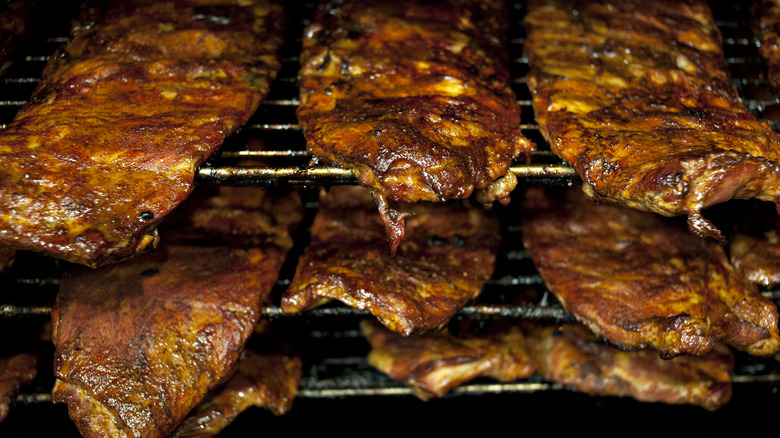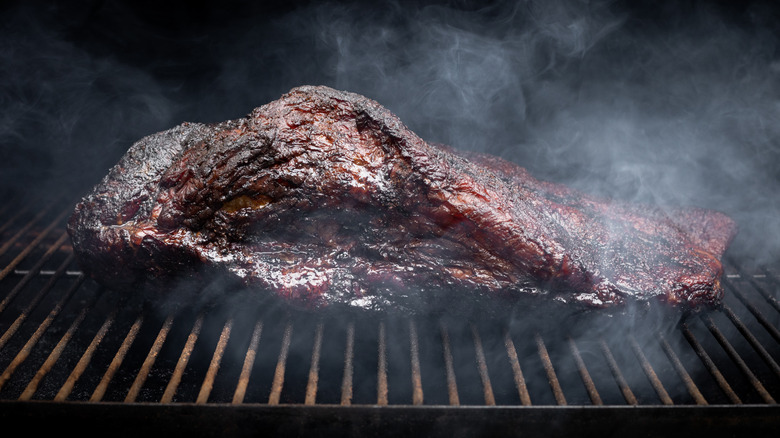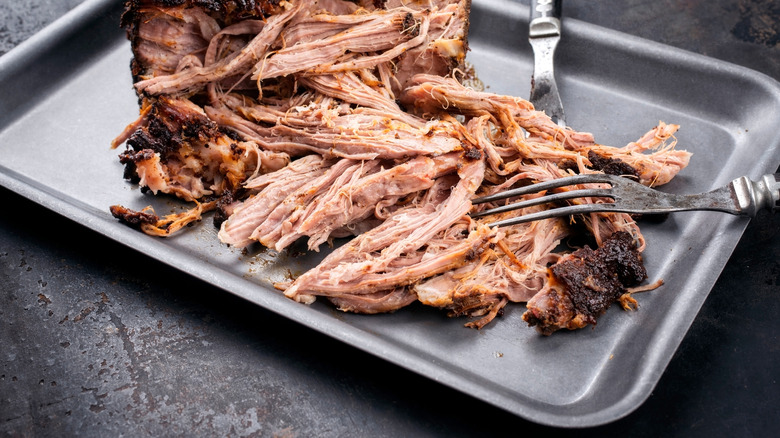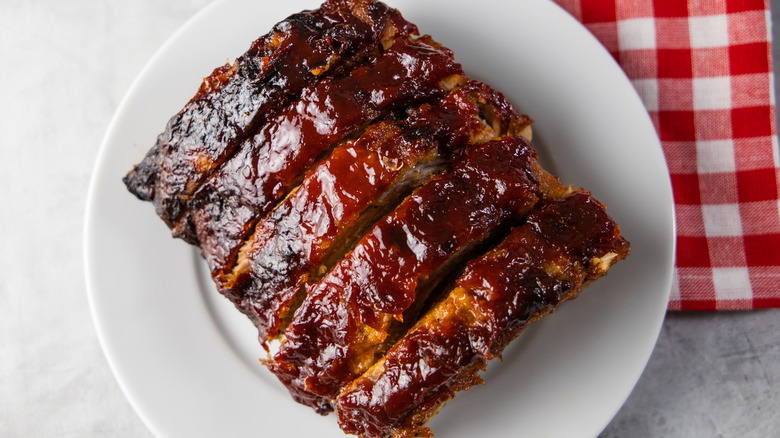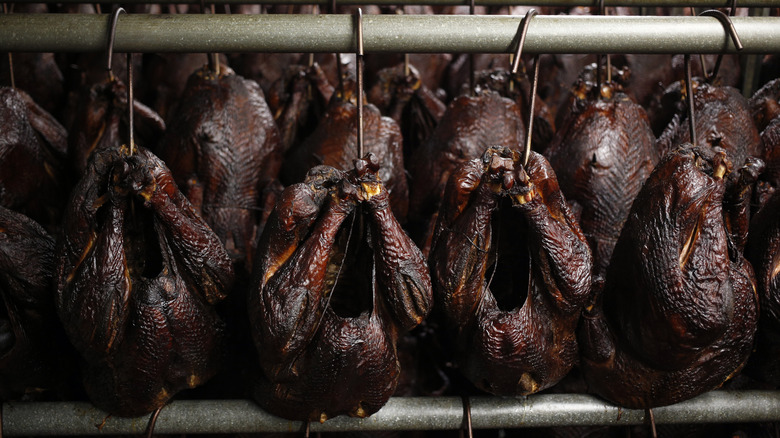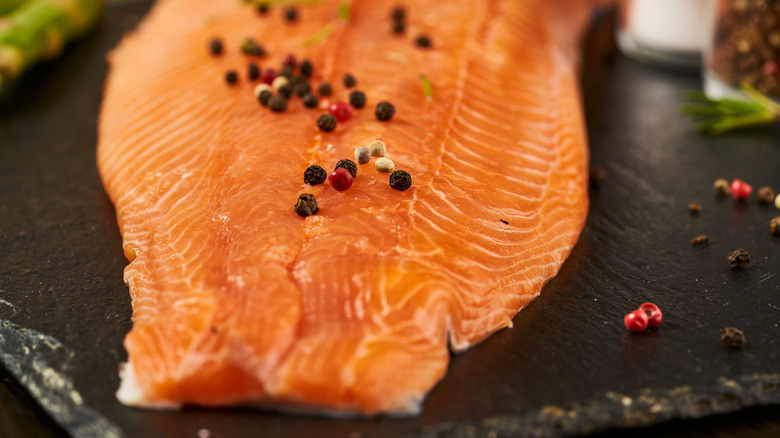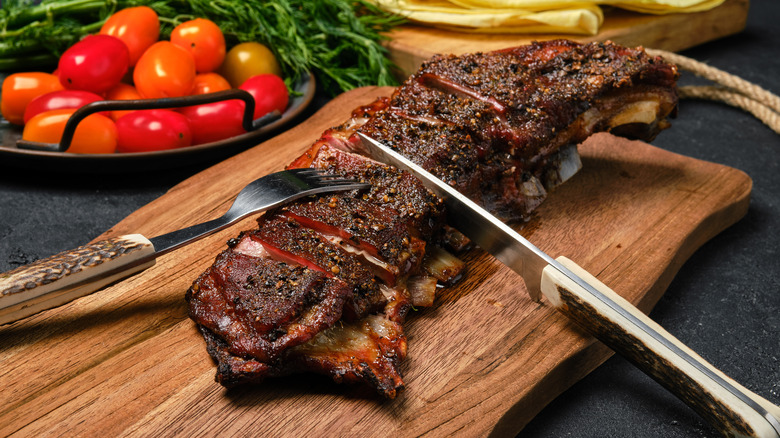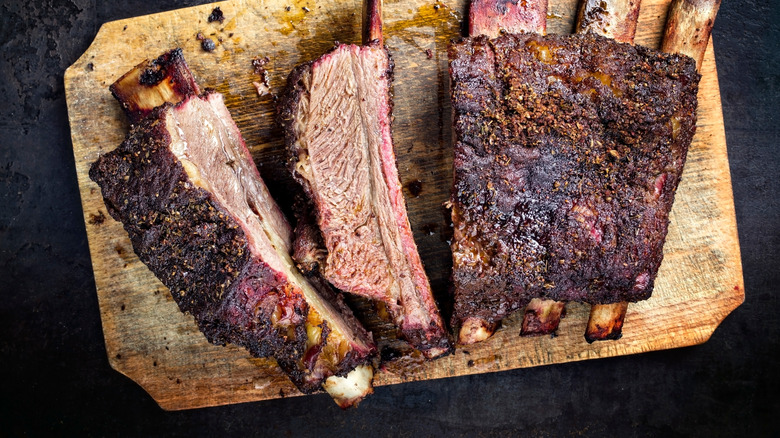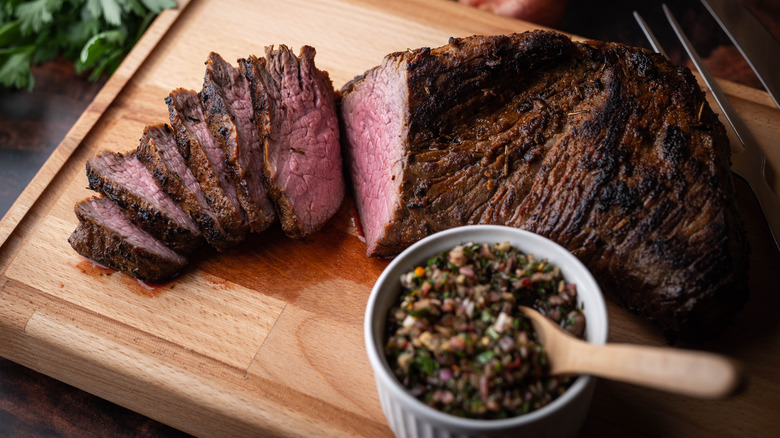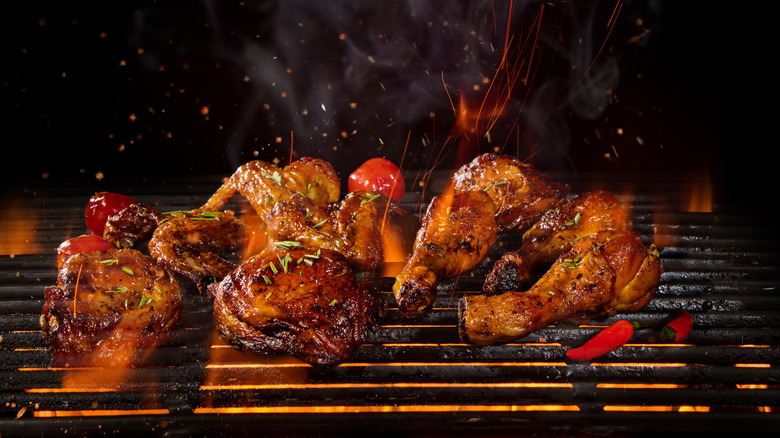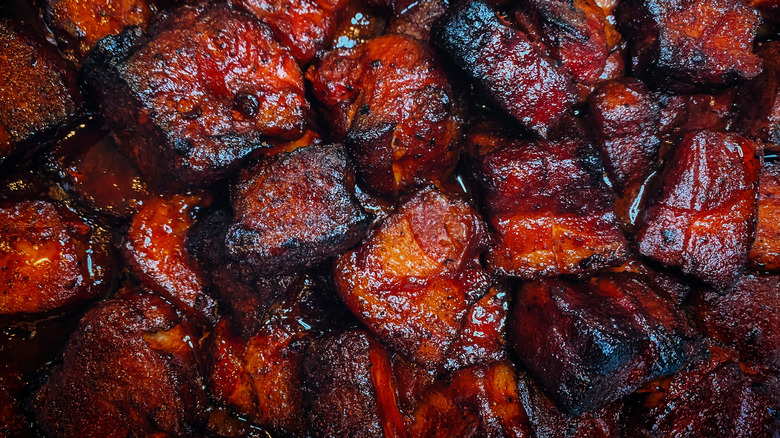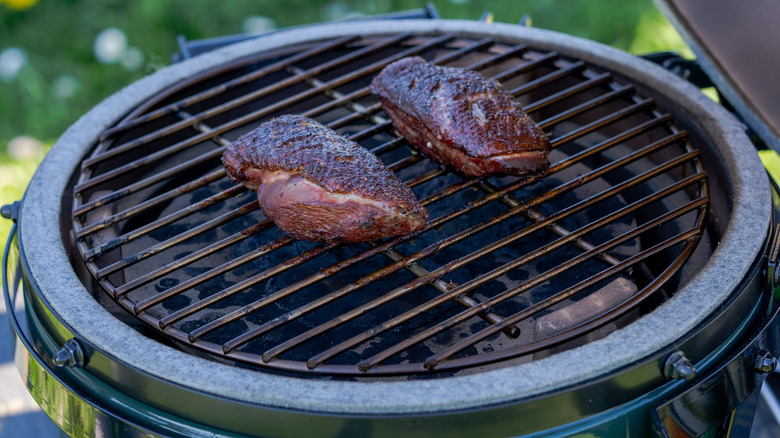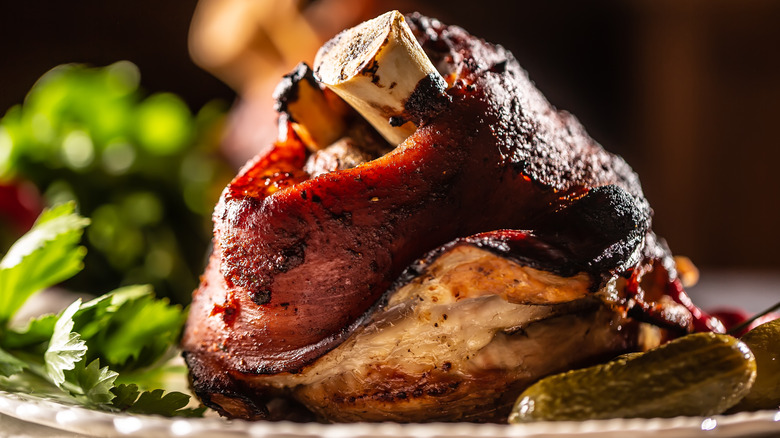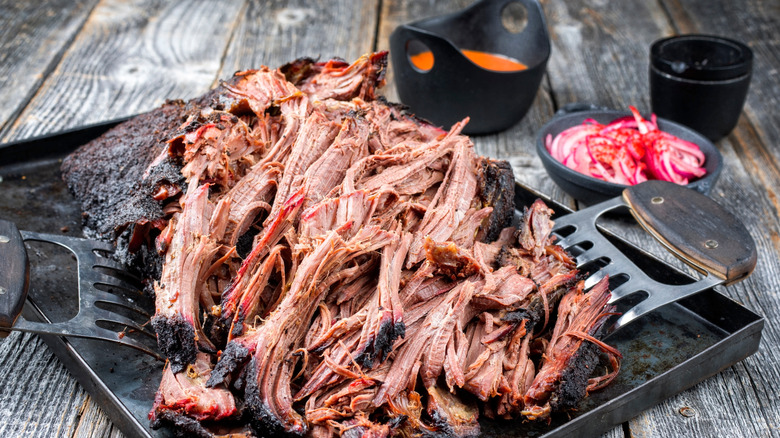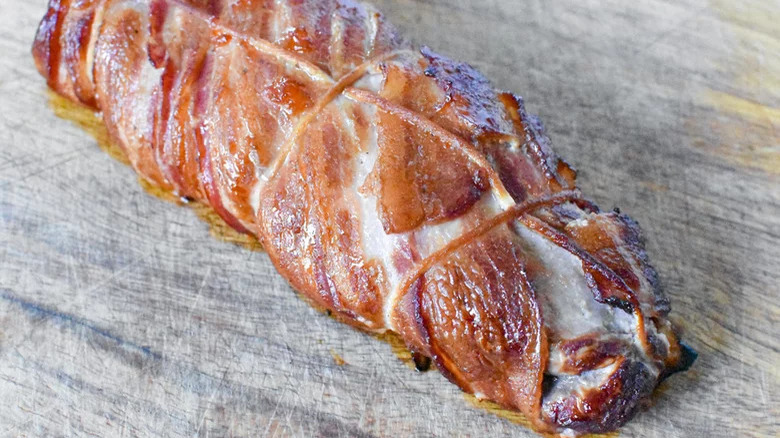The Absolute Best Cuts Of Meat For Smoking
No type of food satisfies your carnivore instincts on a primal level like smoked meat. Every year, the warm weather makes legions of backyard pitmasters emerge from hibernation to try their hands at the ancient art of cooking meat over an open fire. It's no secret that wood smoke can make almost any meat more delicious, but some cuts fare better on the smoker than others. There are also certain cuts of meat that are delicious when smoked but require skill to prepare correctly, while others can be smoked to perfection by barbecue novices.
Whether you're a seasoned master of the art of smoking or just got a smoker for your birthday and are figuring out what you should do with it, we've compiled a list of the absolute best cuts of meat to cook with wood smoke. This list includes various cuts that span from classic favorites you'll find at any barbecue place to underhyped pieces that are unexpectedly great for smoking. It has something for everyone (well, except vegetarians).
Brisket
Brisket is synonymous with Texas barbecue, so it's only natural that it should appear on this list. As with many good cuts of meat for smoking, it is both tough and flavorful. Brisket is cut from a cow's breast, which gets a lot of exercise while the cow is alive. While brisket is unsuitable for applications with a short cooking time, the cut turns into something delicious and tender if cooked low and slow for hours. There are many ways to achieve a perfect brisket, including braising it, but smoking it makes for a drool-worthy result.
You can choose to cook a whole brisket, but unless you're trying to cook eight to 12 pounds of meat at once, it might make more sense to cook half. The two halves of a brisket have different properties: the flat end is leaner, while the point has more extensive fat marbling. If you're worried about the brisket drying out over the fire, choose the point because the fat will baste the meat and keep it moist throughout the cooking process.
Pork Shoulder
Like beef brisket, pork shoulder comes from a part of the animal that gets a workout. In this case, it's the area above the front legs of a pig. Per MasterClass, pork shoulder is generally separated into two different cuts. The upper part of the shoulder is often sold as pork butt (or Boston butt), while the lower part is sold as picnic roast (or simply pork shoulder).
If you love pulled pork, pork butt is the right cut for you. It's filled with fat and connective tissue that melts during hours of smoking, giving you perfectly juicy, shreddable pork. Compared to pork butt, picnic roast is a bit leaner and less forgiving. However, you can still cook it on a smoker or grill. Picnic roast often comes with the skin still attached, so it's a great choice if you like crispy cracklings. Ultimately, both ends of a pork shoulder are very fatty and flavorful compared with some other cuts of pork, so they'll both turn out delicious if smoked for a long time.
Spare Ribs
There are so many types of ribs out there that it can be hard to figure out what you should choose for your smoker, but for your money, the best pork ribs for low and slow cooking are spare ribs. The most common types of pork ribs you'll find at the supermarket are baby backs, spare ribs, and St. Louis-style ribs (which are spare ribs trimmed in a specific way). As their name suggests, baby backs are a cut from near a pig's spine. Spare ribs are cut from lower on the animal near the belly.
As Seven Sons notes, baby back ribs are meatier, leaner, and more tender than spare ribs. That's all great, but it also makes baby backs more expensive than spare ribs. Spare ribs may start out tougher than baby backs, but their higher fat content gives them a more intense, meaty flavor. Spare ribs get super tender if they're allowed to cook for long enough. Since you're busting out the smoker anyway, it makes sense to put in the extra time to cook the cheaper, more flavorful spare ribs to perfection. That said, baby backs are great if you want to grill up some tasty ribs quickly.
Whole turkey
Red meat may be the star at most barbecue restaurants, but poultry can be a great candidate for smoking too. If you've never had smoked turkey before, prepare for your mind to be blown. It will make you forget all the dry, bland, oven-roasted Thanksgiving turkeys you've had in your life.
Smoked turkey has several advantages over traditional roast turkey. For one, the gentle heat of the smoker cooks all the meat evenly instead of turning the white meat into a dry husk. Also, the smoke and the flavor of a good rub liven up the relatively neutral taste of turkey.
Although you could smoke turkey pieces like breasts or legs, we like doing a whole turkey for a couple of reasons. First, with a whole turkey, you get a lot of bones. While Amazing Ribs argues that the idea that bone-in meat is more flavorful than boneless is mostly a myth, they do mention that keeping poultry on the bone helps prevent it from losing juice during the cooking process. With a lean meat like turkey that's prone to drying out, we'll take all the help we can get in the moisture department. Second, a whole turkey takes longer to cook than a turkey breast, which gives it more time to soak up the smoky flavor.
Salmon filets
You don't need to confine yourself to smoking land animals; plenty of water creatures taste great with a hint of smoke. You might think of smoked salmon as something to buy at the bagel shop, but it's easy to make at home as well.
There are two general types of smoked salmon: cold-smoked and hot-smoked (via Solex Catsmo). Both start by curing the salmon in a mixture of seasonings. Cold-smoked salmon is then gently smoked at a low temperature, usually under 90 degrees Fahrenheit. This is the type of salmon that you can shave thinly into silky slices and pile on top of an everything bagel. Hot-smoked salmon is cooked at a higher temperature, more like other types of smoked meat. It's flakier and less delicate in flavor than cold-smoked salmon.
According to Smoked BBQ Source, hot smoking is generally simpler to do at home, though with the right equipment, you can cold smoke in your backyard. The main challenge is to separate the heat source from the food, as you don't want it to heat up past 90 degrees.
Lamb breast
Many different cuts of lamb are good to smoke, but lamb breast might just be the best one. The breast of a lamb contains several parts of the animal that are all great for smoking: brisket, belly, and ribs. It's a forgiving cut of meat because it's chock-full of fat and connective tissue that keeps it moist even if you leave it on the smoker a little too long (via Texas Monthly). It's no wonder this cut is a favorite at barbecue joints in Texas.
One thing to keep in mind is that the flavor of any meat mostly comes from its fat. If you enjoy the unique gaminess of lamb, you'll get that in spades with lamb breast. If that's not your favorite flavor, you may find the taste of lamb breast to be a little intense. Even after it's cooked, lamb breast tends to have big chunks of unrendered fat mixed in with the cooked meat. If you'd rather not pick around all the fat at the table, you can always remove the excess fat and shred the lamb before serving.
Beef ribs
Pigs aren't the only animals that make ribs that are worth eating. Beef ribs are also delectable when smoked. There are two basic types of beef ribs: back ribs and short ribs. Back ribs are cut from near the cow's backbone in a similar fashion to pork baby back ribs. Short ribs are cut from the areas of the rib further from the back (via MasterClass). Unlike pork ribs, the back ribs of a cow aren't very meaty. Short ribs are usually both fattier and meatier than back ribs. Both types of beef ribs can be smoked, but barbecue joints tend to go with short ribs.
The generous amount of meat and layers of intramuscular fat in beef ribs make them a perfect smoking cut. When smoked for long enough, they become rich and meltingly tender. A big beef rib also makes for a visually impressive centerpiece to a meal, with a big chunk of tender beef sitting on top of a giant bone that wouldn't look out of place in "The Flintstones." According to The Houston Chronicle, the classic way to prepare them in Texas is with a simple salt and pepper rub, but many cultures have put their own spin on beef ribs.
Tri-tip
Tri-tip is a cut of sirloin named after its distinctive triangular shape. There are only two tri-tips per cow, and they were historically thought of as off-cuts, either ground into hamburger or chopped into stew meat. According to the Santa Maria, California tourist website, tri-tip first gained prominence when local business owner Bob Schutz started using it to make what is now called Santa Maria-style barbecue. In that region, it's traditionally smoked over red oak and served with beans, salsa, and salad (via Santa Maria Valley).
Tri-tip differs from many other barbecuing cuts because it's boneless and lean. The method for cooking is sort of a hybrid between grilling and smoking; first, you sear it over a fire and then let it slowly smoke until it reaches the desired doneness. You can serve it medium-rare, just like a smaller cut of steak.
Besides proper cooking, the carving is the most important thing to pay attention to with tri-tip. Cutting this piece of meat is tricky because the grain changes direction. To cut it perfectly, you have to carve half of it in one direction, then change your knife angle to make sure the whole thing is carved against the grain to make tender slices.
Chicken wings
We're not going to argue against the classic deep-fried and sauced Buffalo wing because that's one of the most delicious ways to prepare the tastiest part of a chicken, but there are many other great ways to cook wings. Wings are perfect for the smoker; if you don't believe us, pay a visit to 17th Street Barbecue, which landed on our list of the best chicken wing restaurants in America.
Everyone knows the best part of a chicken wing is the crispy skin. A smoker is great for adding delectable woody flavor to pieces of meat, but it's not really going to get hot enough to give your wings the crunchy exterior you crave. For the best smoked wing experience, follow 17th Street's lead and use a two-stage cooking process: First, season the wings with a spice rub and smoke them to give them the flavor you want. To finish, throw them on a hot grill to crisp up the skin.
Pork belly
As we've previously reported, the biggest mistake you can make with pork belly is trying to cook it too fast and hot. This cut is filled with fat and connective tissue. It becomes unctuous and silky if treated gently but is unpleasant to eat if you try to rush it. What better way to cook it than by smoking, which not only treats it with the gentle heat it needs but also adds layers of flavor?
Everyone loves bacon, and American-style bacon is just pork belly that is cured with salt and a few other ingredients, then smoked (via S. Clyde Weaver). If you smoke your own pork belly at home, you can recreate many of the sweet, salty, fatty, savory notes you love in bacon. You can even go whole-hog, so to speak, and follow our instructions for making homemade bacon. Our recipe jerry-rigs an oven to make an impromptu smoker, but there's no reason you couldn't use a real smoker to make it.
Duck breast
Speaking of bacon, we have a croque madame recipe that calls for a novel bacon substitute: cured and smoked duck breasts. Duck is a natural candidate for smoking because it has a strong flavor that won't get overwhelmed by the fire, and it's quite fatty, which we've established is a huge asset for smoked meats. In fact, duck is so fatty that it's a good idea to puncture the skin beforehand to let the excess grease escape during the cooking process.
Another more complex take on smoked duck is the Sichuan Chinese classic banquet dish tea smoked duck. While this dish is quite labor intensive for a home cook to pull off, it's delicious and worth trying out. According to Z and Y Restaurant, the traditional preparation for this dish requires four steps. The duck is first seasoned with a marinade and then roasted. After that, it's smoked over Camphor tree trimmings, then fried to crisp up the skin.
Pork knuckle
We know what you're thinking: "Pigs have hooves; what part of a pig could possibly be the knuckle?" Confusingly, pork knuckle has nothing to do with a pig's feet. Instead, it's another name for pork shank, particularly the shank of a pig's front legs. It's cut from the leg of the pig directly beneath the shoulder (via Professional Secrets).
The knuckle contains a big piece of the pig's leg bone and is surrounded by a thick layer of fatty skin. While that means that there isn't a ton of meat on it compared to some other cuts of pork, it's quite flavorful, and the skin is the best part. You can smoke it whole, but make sure to crank the heat at the end of the cooking process to turn the outside into a crunchy pig crackling.
Smoked pork knuckle is delicious on its own, but the bones and leftovers can be used to flavor other dishes like split pea soup.
Beef chuck
Beef chuck comes from a cow's shoulder. Just like pork shoulder, this is a load-bearing area of the animal with muscles that get a lot of usage during the animal's life. That means it starts out tough but has an intense flavor (via Steak University). If you cook it for long enough at a low temperature, it becomes quite tender. Its strong beefy flavor and relatively affordable price make chuck a popular choice for braised pot roasts and stews.
A classic pot roast is delicious, but braising is not the only way to cook something slowly and gently. Chuck is great on the smoker as well. According to Certified Angus Beef, chuck is a great choice for making pulled beef. A three-pound chuck roast will take about half a day of smoking to reach tender deliciousness, but the wait is worth it. Chuck is a good cut of beef to buy if you don't want to spring for brisket, which The Wall Street Journal notes is a lot more expensive than it used to be.
Pork tenderloin
If you want to make smoked pork without the long cook time required for pork shoulder or pork belly, pork tenderloin is the way to go. This recipe from Mashed can be ready in under two hours and produces a showstopping centerpiece for any dinner. It's a great recipe for aspiring pitmasters who don't have a lot of experience smoking meat.
Since tenderloin doesn't have a lot of connective tissue or fat, it doesn't need long hours of smoking to make it edible. However, cooking it on the smoker does have its own set of challenges. Pork tenderloin is, of course, tender, but it's also lean, which means it's prone to drying out. The Mashed recipe remedies this by wrapping the tenderloin in bacon. The fat in the bacon should protect the tenderloin during the cooking process and add a lot of delicious flavor to boot. Just make sure to find thin-cut bacon — the thick-cut stuff could get tough in the smoker.
